Bulk loading external shipments can help expedite shipping orders that are shipped through external systems.
Important Note: Only bulk edit in batches of 500 or less. If you select a batch larger than 500, you will see significant system slow-downs.
Important Note: Only bulk load in batches of 5,000 or less except for Orders. You can only bulk upload 1,000 Orders at one time.
- Best practice is to perform large bulk edits and/or loads outside of peak business hours
How to Bulk Load External Shipments
The External Shipment process allows you to modify an Order in Infoplus to reflect shipping that has occurred outside of Infoplus (i.e., through the FedEx website).
Once executed, the order record will be updated with shipping details and a related Parcel Shipment record will be created.
You can create an External Shipment on one order or Bulk Load a .csv or Excel file containing multiple external shipments (steps below).
When bulk loading External Shipments, you will need to indicate the following:
- Order Number
- Carrier
- Parcel Account
- Tracking Number
You can download a template file with these fields (and more) in the first step of the bulk load process.
Bulk Load External Shipments
- Access the "External Shipment" Table. Two methods:
From the Dashboard: Click the “Warehouse Operations” tab, click the “Fulfillment” App, then click the “External Shipment” Table.
From the Quick Actions shortcut: Press a dot (period) on your keyboard, then select “External Shipment” from the list of Quick Actions. - Click the Actions menu and select Bulk Load. The Upload File step in the External Shipment Bulk Load process appears:
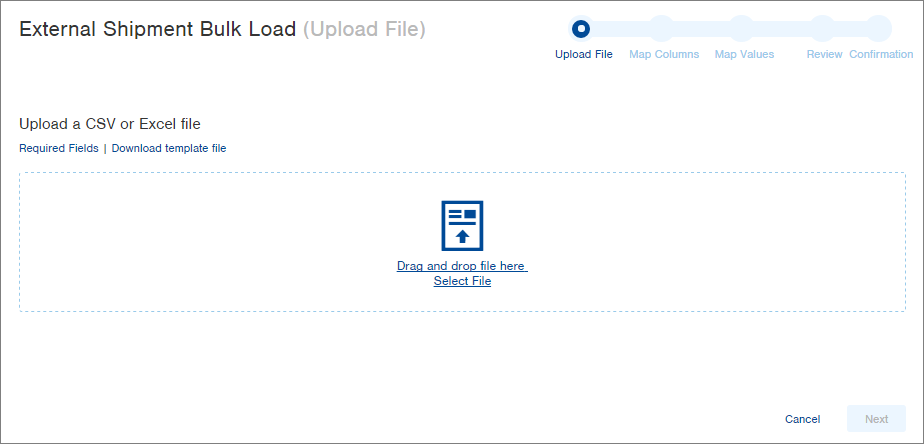
NOTE: When working through the Bulk Load steps, clicking the browser's Back button will take you out of the Bulk Load and return you to the table. You cannot use the Back button to move back a step in the process. - Either drag and drop the file to be uploaded onto the icon, or click the document icon to select a file on your computer. NOTE: To view a list of fields required for upload, click the Required Fields link in the top left. To download a template file, click the Download template file link in the top left. The template file will include more than the required fields, as you may want to upload more information.
-
After loading the file, click Next. The Map Columns step in the process appears.
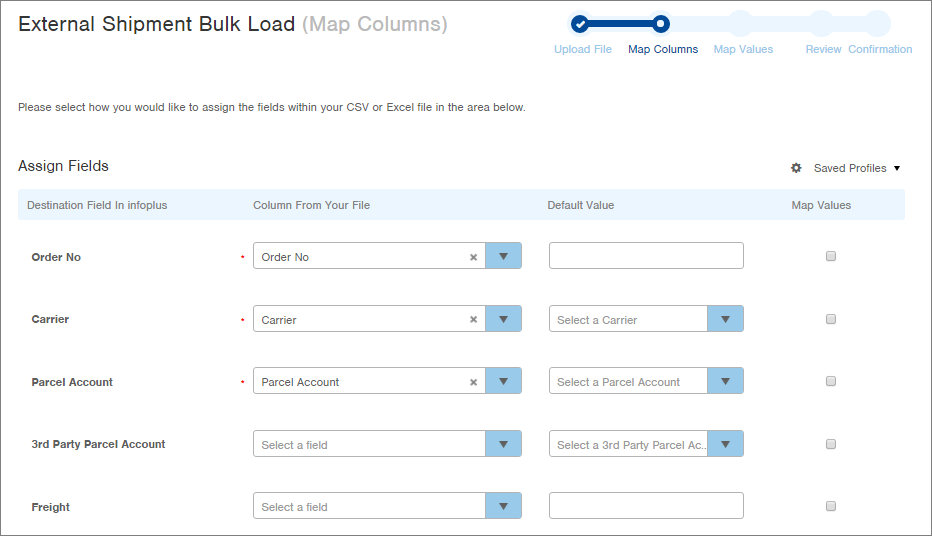
- Work through each field, working from left to right, to consider your mapping options and make the proper selections. You can map fields to your source file or enter values for each field in this screen.
NOTE:
- If you do not specify a Freight Amount, a default value of $0.00 will be used.
- If you do not specify a Weight, a default weight of 0 lbs will be used.
- If you do not specify a Residential value, "True" will be the default indicating the shipment went to a residential location.
If you saved a profile (which saves all selections in the "Map Columns" screen), click the Saved Profiles drop-down menu and select the Saved Profile. NOTE: If you have not saved a profile and would like to save the mapping you are currently developing, you will have a chance to do so in upcoming steps.
DETAILS ABOUT EACH COLUMN IN THE SCREENSHOT ABOVE:"Destination Field in Infoplus" (First column)
- These are the fields in the External Shipments Table in Infoplus.
"Column From Your File" (Second column)
- Select the column from your source file that should be mapped to the Infoplus field on its left. If a field in your source file has the same name as an Infoplus field, it will automatically be selected for you. You can override any automatic selections if necessary. Asterisks (*) indicate required fields for the upload.
"Default Value" (Third column)
- For each field, you can select a Default Value. This is typically done if your source file does not contain the column that needs to be uploaded, or if the column is blank, or if you want to override existing values in your source file. For example, if the Carrier is UPS Ground for every record you are uploading, select a Default Value from the list of Infoplus values. When the above data is uploaded, every record’s Carrier field will display the Default Infoplus value. NOTE: If the column in your source file contains values, you cannot select to map the column AND select a Default Value. You need to do one or the other. To “unmap” a column, click the X next to the field name in the “Column From Your File” section.
When the above data is uploaded, every record’s Carrier field will display the Default Infoplus value. NOTE: If the column in your source file contains values, you cannot select to map the column AND select a Default Value. You need to do one or the other. To “unmap” a column, click the X next to the field name in the “Column From Your File” section.
"Map Values" (Fourth column containing checkboxes) - The Map Values checkbox allows you to connect values from your source file to values in Infoplus. For example, perhaps you display the Carrier of UPS Ground as “UPSG” in your data source. Infoplus doesn't use “UPSG” to represent UPS Ground, so it will not be able to upload that information. To avoid having to edit your source file to match what Infoplus wants, you can connect your value to the Infoplus value. After clicking Next, you will be presented with a screen to map each record where you selected the Map Values checkbox. - After making your mapping selections, click Next. If you had selected any of the Map Values checkboxes, a Map Values screen will appear for each checkbox selected (otherwise, the Review screen will appear and you can move to step #7).
In the Map Values window, select the appropriate Infoplus value(s) for each source file value. Here’s an example of the Map Values screen for the Carrier field: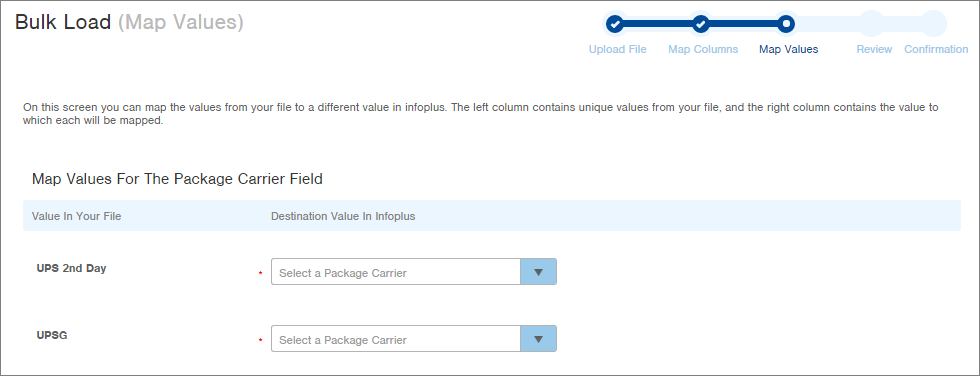
In the above example, the source file contains a Carrier of UPS 2nd Day and UPSG. These entries do not match the value options in Infoplus, so we will map these values accordingly. For example, the completed Map Values screen may look like this: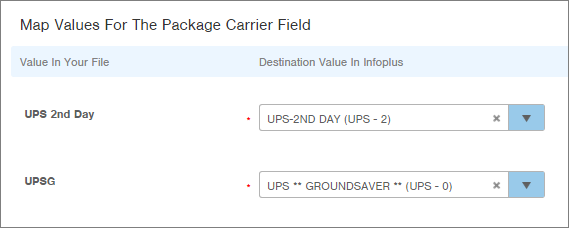
When Infoplus encounters a value of UPSG, it will know to use UPS ** GROUNDAVER ** (UPS – 0) as the value.
NOTE: You can map many value variations in a field (i.e., UPSG, UPS Ground, UPS Grnd, etc); however 100 variations on one field's values is the limit. - After making any Map Values selections (if required), click Next. The Review screen will appear.
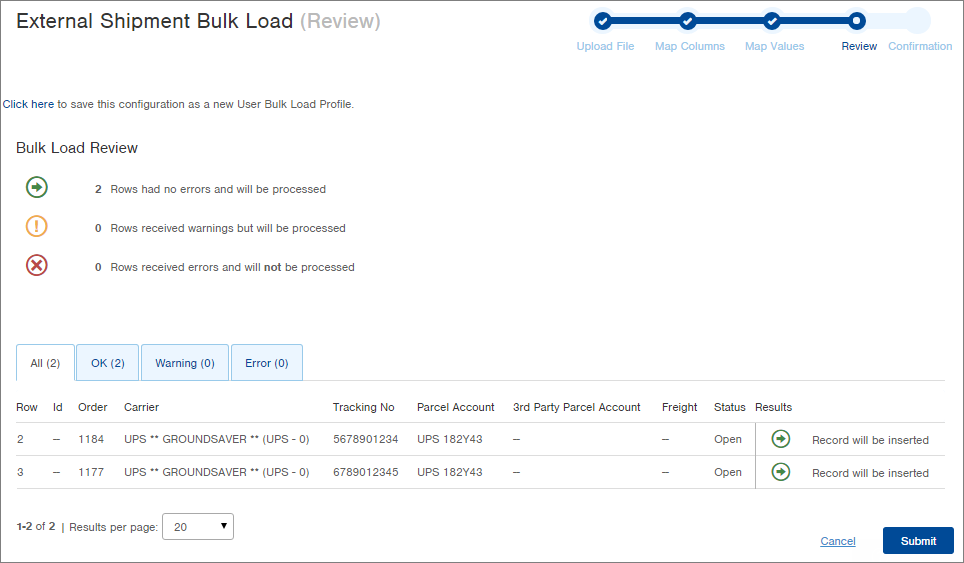
The “All” tab displays the results of each record in your data source. You can narrow your view of results by clicking on the other tabs (OK, Warning and Error). In the example above, all records were OK, so the results indicate that the records will be inserted. Common errors involve missing required fields or unknown values in fields. Some errors may require you to edit your source file, but many can be fixed with proper mapping selections (see Step 5 above). You will need to start the upload process over to fix mapping selections. - If you would like to save your mapping selections to be used on a future mapping of records to this Table, click the Click Here link at the top of the window.

Enter a name for the Profile (i.e., Customer Data) and click Save. The next time you perform an upload and you want to use similar mapping, you can select the Profile during the Map Columns step of the process. NOTE: You can make mapping edits after selecting the profile, and you will have an opportunity to save your changes in the Review screen. - To perform the upload, click Submit. The Confirmation screen will appear with the final results.
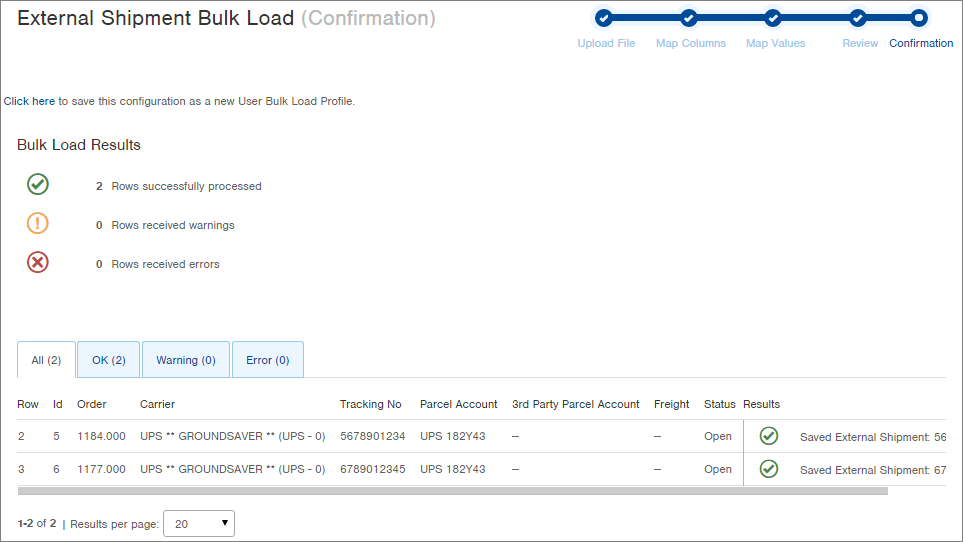
- The upload is complete. At this point, you have created the External Shipment records, but you have not yet executed the External Shipment which is what updates the Order record and creates the Parcel Shipment record. See Execute External Shipment.

-1.png?height=120&name=InfoPlus-Primary-Logo%20(1)-1.png)